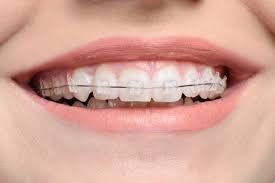Many people ask, “What are dental braces and how do they work?” Dental braces are orthodontic devices used to correct misaligned teeth and jaws, helping to enhance both appearance and functionality. These appliances gradually shift the teeth into their desired positions through consistent pressure over a period of time. They not only straighten your smile but also improve oral health by making teeth easier to clean, reducing the risk of decay, gum disease, and jaw issues.
Types of Dental Braces You Can Choose:
Modern orthodontics offers a variety of Dental Braces to suit different needs and preferences. Your orthodontist will recommend the best type based on your dental condition, budget, and lifestyle. The most common types of dental braces include:
- Metal braces: Traditional stainless steel braces that are durable and effective.
- Ceramic braces: Tooth-colored brackets for a more discreet look.
- Lingual braces: Placed on the backside of the teeth, hidden from view.
- Clear aligners: Removable trays like Invisalign, popular for mild to moderate corrections.
Each option comes with its own benefits. For example, metal braces are great for complex cases, while clear aligners offer convenience and aesthetics for those seeking a subtle solution.
Components That Make Braces Work:
To understand how braces work, it’s essential to learn about the components that drive the process. These elements work together to apply gentle, continuous pressure on your teeth, guiding them into proper alignment. Key components include:
- Brackets: Small metal or ceramic pieces attached to each tooth.
- Archwire: A thin wire threaded through the brackets that exerts pressure.
- Ligatures: Elastic bands that hold the archwire to the brackets.
- Bands: Metal rings that fit around the molars to anchor the braces.
- Elastics: Rubber bands used to correct bite and jaw alignment.
Over time, these components work in harmony to reshape the bone and shift the teeth into their correct positions.
Benefits Beyond a Straighter Smile:
Braces offer far more than just cosmetic improvements. By realigning your teeth, they can significantly enhance oral health and overall comfort. Some of the top benefits include:
- Improved bite alignment, reducing stress on jaws and muscles.
- Easier brushing and flossing, lowering the risk of cavities and gum disease.
- Better speech and clearer pronunciation in some cases.
- Prevention of tooth wear caused by improper alignment.
- Boosted self-confidence from a more attractive smile.
Braces address both functional and aesthetic concerns, making them a valuable long-term investment in dental well-being.
The Treatment Process: What to Expect
Getting dental braces involves several stages, each playing a crucial role in achieving the desired outcome. Understanding the treatment timeline helps you prepare for the experience and stay committed throughout. The typical process includes:
- Initial consultation to assess your teeth and bite.
- Diagnostic records like X-rays, photos, and impressions.
- Placement of braces during a painless in-office procedure.
- Regular adjustment visits every 4–8 weeks to track progress.
- Use of retainers post-treatment to maintain results.
Most treatments last between 12 to 36 months, depending on the complexity of the case. Patience and cooperation with your orthodontist’s instructions are key to success.
Caring for Your Braces Properly:
Maintaining good oral hygiene and caring for your Dental Braces Treatment can prevent complications and ensure a smoother treatment journey. Braces require a bit of extra attention to keep your teeth and appliances clean and functional. Here are some essential care tips:
- Brush after every meal using a soft-bristle toothbrush and fluoride toothpaste.
- Use interdental brushes or floss threaders to clean between teeth and wires.
- Avoid sticky, hard, and sugary foods that can damage brackets or cause decay.
- Rinse with antibacterial mouthwash to reduce plaque buildup.
- Attend all scheduled orthodontic appointments for timely adjustments.
Proper care not only keeps your teeth healthy during treatment but also contributes to a faster and more successful outcome.





Comments